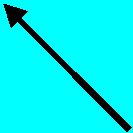DOM
Basis
The objective of DOM is to score more points than your opponent. Each player is dealt eight cards and these are then played alternately to form a 4x4 square, the score being noted as each card is played.
| |||||||||||||||||||||||||||
 |  | ||||||||||||||||||||||||||
| Diagonal X | Diagonal Y |
|---|
Scoring
As each card is played, the score is noted for the row and column which it occupies. For instance, a card placed in position A scores in Row 2 and Column 1 and a card in position B scores in Row 4 and Column 3. If the position also lies on one of the two major diagonals, then this line is also scored; so that card C scores in column 4, Row 1 and Diagonal Y, and card D scores in column 3, Row 3 and Diagonal X.
To score, the pip value of each card in a row, column or diagonal is summed. This applies every time a card is played, irrespective of how many cards (1,2,3 or 4, as the game progresses) might be in the row, column or diagonal. Twos count 2, threes count 3, fours count 4, etc, and all the court cards count 10. Aces count both 1 and 11, so any line with an ace must be scored twice, once at each of the two values. The score is calculated as 1 point for every multiple of 3, one point for every multiple of 5 and one point for every multiple of 7 on the pip-count. The possible scores are shown in the table.
| Pip Count | Points Score | Pip Count | Points Score |
| 1 | 0 | 23 | 0 |
| 2 | 0 | 24 | 8 (8x3) |
| 3 | 1 (1x3) | 25 | 5(5x5) |
| 4 | 0 | 26 | 0 |
| 5 | 1 (1x5) | 27 | 9 (9x3) |
| 6 | 2 (2x3) | 28 | 4 (4x7) |
| 7 | 1 (1x7) | 29 | 0 |
| 8 | 0 | 30 | 16 (10x3)+(6x5) |
| 9 | 3 (3x3) | 31 | 0 |
| 10 | 2 (2x5) | 32 | 0 |
| 11 | 0 | 33 | 11 (11x3) |
| 12 | 4 (4x3) | 34 | 0 |
| 13 | 0 | 35 | 12 (7x5)+(5x7) |
| 14 | 2 (2x7) | 36 | 12 (12x3) |
| 15 | 8 (5x3)+(3x5) | 37 | 0 |
| 16 | 0 | 38 | 0 |
| 17 | 0 | 39 | 13 (13x3) |
| 18 | 6 (6x3) | 40 | 8 (8x5) |
| 19 | 0 | 41 | 0 |
| 20 | 4 (4x5) | 42 | 20 (14x3)+(6x7) |
| 21 | 10 (7x3)+(3x7) | 43 | 0 |
| 22 | 0 | 44 | 0 |
44, that is four Aces, is the maximum pip-count for four cards.
With a little experience, these point scores are easily remembered. Clearly, during play, there is an incentive to develop pip-counts which are multiples of two of the three numbers; that is 15, 21, 30, 35 and 42. A pip-count of 42 can be achieved only in a line having two Aces and two court cards, or in a line with three Aces and a 9.
Bonus Scores
In addition to the pip-count score, each line can provide the following bonuses:
| Pair | 2 points |
| Three of a kind | 6 points |
| Four of a kind | 12 points |
| Run on four cards | 4 points |
| Flush on four cards | 4 points |
| Running flush on four cards | 8 points |
No points are gained for runs or flushes on less than four cards
Play
The cards are shuffled and dealt, eight to each player. Non-dealer plays first, placing a card to set one corner of the square. Play is then alternate and cards can be placed anywhere in the square. Obviously, the position of the last card to be played is forced. There is a slight advantage in being the dealer so the score must be taken over two games with the deal changing hands.